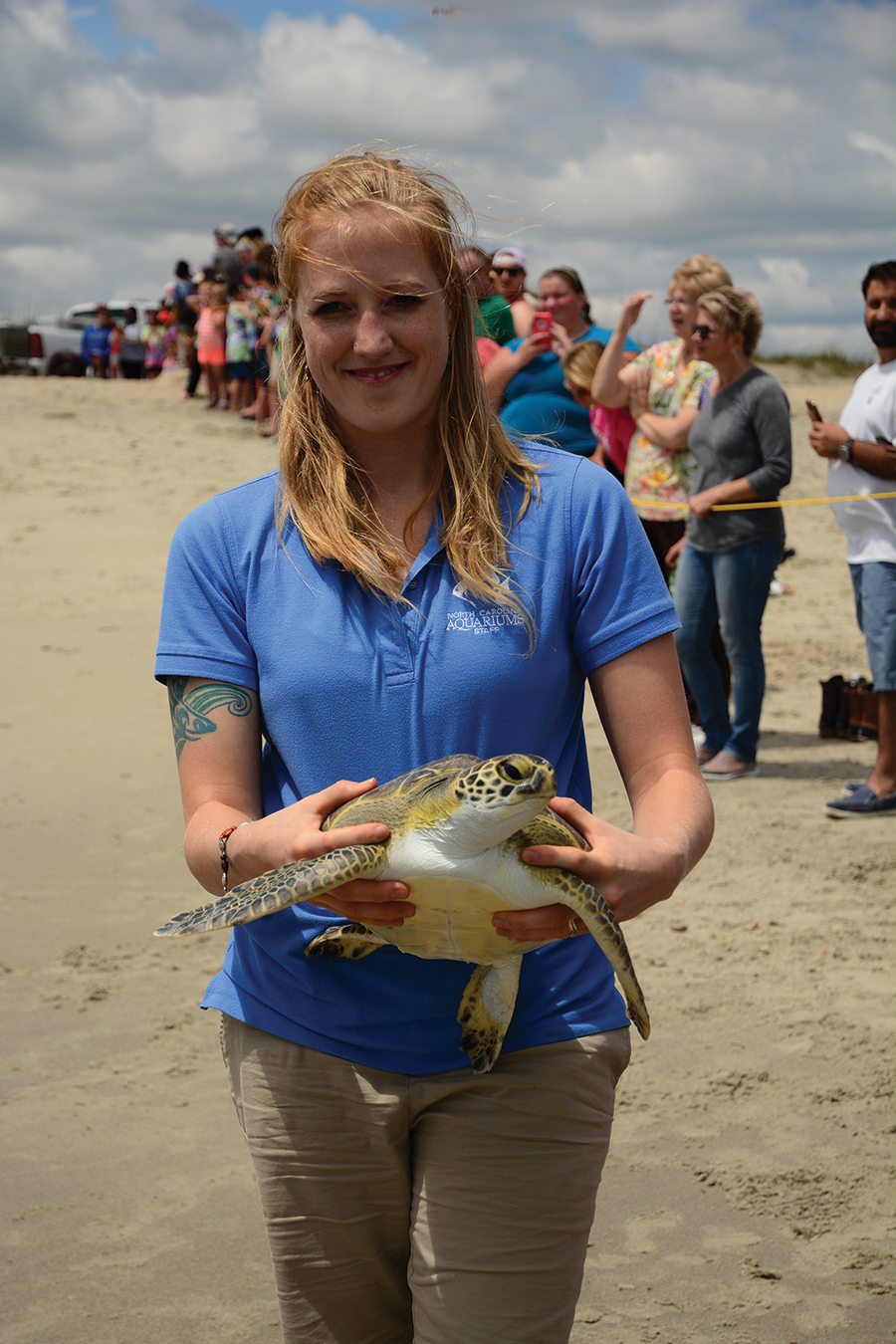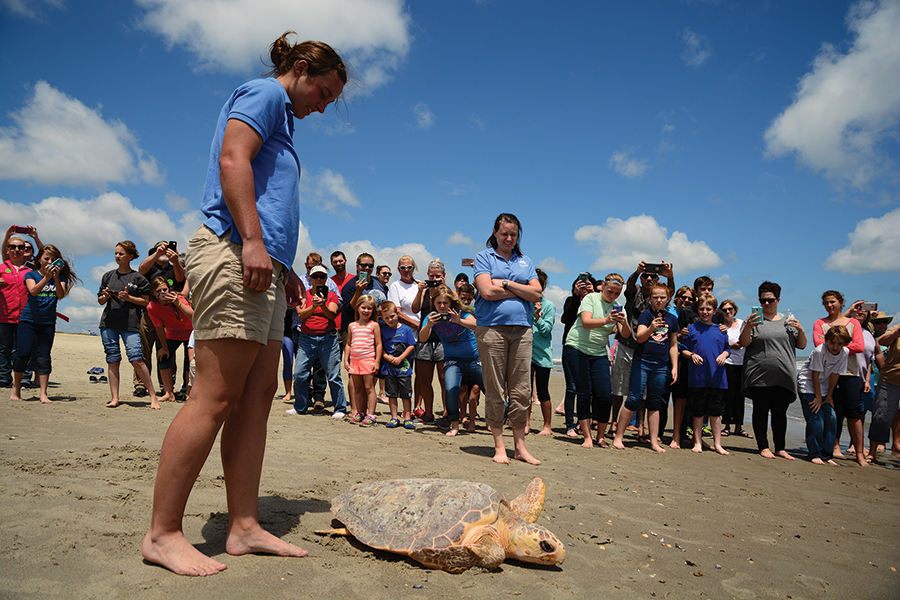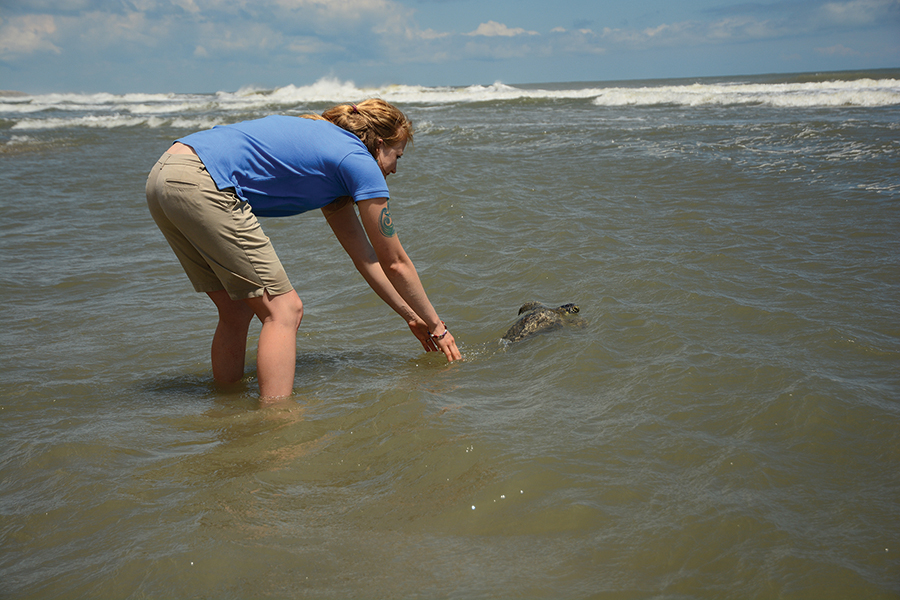The fate of sea turtles may depend upon the aid of those who love them
Story & Photographs by Virginia Holman

Long Odds
Nearly 15 years ago, around midnight, I stood on a beach in Tortuguero National Park in Costa Rica with my husband and son and a handful of other travelers, hoping to catch a glimpse of a nesting green sea turtle. The moon was nowhere to be seen, so we walked carefully in the dim starlight, shuffling in a single-file line. Our guide shone a small red light on the sand, scanning for turtle tracks. We whispered, looked toward the faint glint of the sea, and hoped. After 15 minutes or so, our guide became a bit impatient, told us to stay put and went off with his red penlight to look for turtles. We craned our necks as he shone the faint beam across the beach, walking farther and farther away from where we stood. In the distance, his light began to look an awful lot like the lit tip of a cigarette. I was annoyed, contemplating whether to complain politely when my son tapped my arm.
“There’s one,” he said. I scanned the beach but came up empty. Then I heard the soft scrape of a turtle shell on the sand. My eyes were still adjusting to the dark when I saw a turtle that looked like a large gray boulder. Someone went off to alert our guide. “There’s another,” he said. “And another.” Soon we realized there were six or seven green turtles hauling their heavy bodies across the sand. We stepped aside and watched these giants drag themselves far above the tideline to dig a nest. The turtles flung sand several feet in the air as they dug and burrowed into the beach. At last they stilled, and we were able to watch one turtle quietly. As a mother who had labored through a long childbirth, I felt a certain physical and emotional kinship with that turtle. Her body was full of the future. Her face streamed with tears (said to manage the balance of salt in her body but that might be interpreted as weeping) and she was simultaneously tremendously powerful and wholly vulnerable. Then she opened and released nearly a hundred eggs into the nest she’d made. They looked like glistening Ping-Pong balls. The guide told us that only one in a thousand female sea turtles grows to maturity and returns to shore to nest again.
Soon the turtle pulled herself back to the sea and slipped into the dark water. It was impossible not to experience a bit of existential wonder. How improbable, how mysterious, was her hatching? How fraught was her return to nest in the area where she’d come alive, incubating beneath the warm sand? Add to that the long odds of any one person seeing this mature sea turtle in the wild. That’s the sort of wonder I mean. The kind that makes you ache with the awareness that you are too briefly alive in this living world.

Survival at Sea
When I moved to the coast, I hoped to glimpse sea turtles, and I thought the first one I’d see would be at a nesting site. Instead, I was surprised to see loggerheads in the waters around Carolina Beach all summer long. Sometimes one would be visible swimming in the green sunlit waves, but mostly I saw their heads as they surfaced for air. The first time a loggerhead rose for breath near the bow of my kayak, I was startled. A 20-year-old loggerhead turtle may have a head the size of a supermarket cabbage, with powerful jaws and a carapace the size of an ottoman. Loggerheads are indiscriminate diners. They love jellyfish, but they also eat crunchy whelks, conchs, horseshoe crabs, clams and mussels. If it’s in the water and looks like food, a loggerhead will likely take a bite. That’s a great survival strategy for the species, but only as long as what looks like turtle food isn’t something else.
Unfortunately, an increase in ocean debris — most notably single-use plastic shopping bags and fishing line — are significant contributors to the sea turtle population decline. Plastic bags discarded on land easily flow into our waterways. Curious loggerheads, thinking that these bags are jellyfish, will try to eat them. Plastic bag consumption usually leads to illness and death. Discarded fishing line also presents a hazard, wrapping around turtle fins and shells, causing injury and restricting movement. At the coast, we remind our visitors to avoid using single-use bags and to place trash and damaged fishing line in the proper receptacles. In addition, fishing nets are a proven hazard to sea turtles, and as commercial fishing has increased exponentially in the last 20 years, the risk to migrating sea turtles has spiked. Sea turtles must surface regularly to breathe, unlike fish, and the stress of entanglement often causes them to drown within a relatively short period of time. The number of sea turtles that have perished from nets isn’t easily tallied, as they are considered fishing “bycatch,” or collateral damage.
In the late 1970s, the National Oceanic and Atmospheric Administration (NOAA) began developing nets that had Turtle Excluder Devices (TEDs). These cleverly designed “escape hatches” allowed turtles to slip through the nets while retaining the targeted species. As the nets were slowly adopted, however, it became clear that the older and bigger turtles proved too big for the excluders and they usually perished if caught. Over the last decade, NOAA has mandated larger excluder openings as a corrective. Most U.S. trawling operations are obliged to use TEDs, and the technology is being employed by some other nations as well — something that bodes well, since sea turtles are international travelers. For the most part, commercial fishing boats are embracing the changes as a way to reduce bycatch.
Although there isn’t a single reason for sea turtle decline, it’s shocking that these ancient inhabitants of the Earth — they have been around for 150 million years and survived the extinction of the dinosaurs — are listed as endangered species. The story of sea turtles is one of our planet’s great survival stories. And if humans are the cause of the turtles’ demise, many are also working to help these beautiful swimmers.
Dawn Patrol/Evening Watch
Each beach community along the Cape Fear coast has a sea turtle monitoring program. During nesting season, from May to September, volunteers patrol the coastline each morning at dawn. Some ride fat-tired bicycles, some are on foot, and some, like the volunteers with the Pleasure Island Sea Turtle Project, ride the strand on Gators — four-wheel-drive golf carts with rugged wheels capable of riding in soft sand.
Veteran turtle volunteer Rob Pomeranz took me on a ride-along this spring. We rode the length of Carolina Beach and back while another volunteer drove the length of Kure Beach to Fort Fisher. Each Gator is equipped with a tool box full of the items we might need if we see a nest. There are wooden stakes, orange plastic fox netting to prevent predators like foxes and raccoons from excavating eggs, and several large egg crates. “Sometimes if a nest is too close to shore or in a high-traffic area, we must excavate it and relocate it to a safer location,” says Pomeranz.
He has seen evidence of many turtle crawls over the years: “Nesting sea turtles leave tractor-like tracks from the shoreline to the beach.” They tend to slip onto shore deep at night, so it’s rare to see the turtles. A few years ago he got lucky and saw an enormous loggerhead onshore before she slipped back to sea. “I have a picture of it on my Facebook page.” He smiles and shakes his head. “That was a great morning.”
Sometimes Pomeranz gets emergency calls for sea turtle help. “Once we got a call from a policeman on patrol that an unidentified nest was boiling on Carolina Beach near the Tiki Bar, but that the babies were going in the wrong direction. All the lights from a nearby building confused the babies, and they were crawling up to the dunes and heading into parking lots. It was a mess! We were fishing babies out of the swimming pool. That’s why it’s important to identify nests.” When an identified nest comes close to hatching time, black silk fencing is constructed around the nest, creating a fabric chute that helps direct the babies to the ocean. Volunteers often sit with a nest round the clock when a turtle hatching, or “boil,” is imminent.
Then, three days after the hatch, the nest is excavated for unhatched eggs and stragglers.
Nancy Busovne, volunteer coordinator for the Pleasure Island Sea Turtle Project for the last 15 years, says that the program has helped educate many seaside businesses and homeowners about the needs of nesting turtles. They keep the beachfront lights off at night and instruct people to step away from any turtle they see and call 911. They will send someone out to assist. Though we all love sea turtles, it’s important to realize that when they are on land, they are stressed. Lights from flashlights, cellphones or porches can disorient and blind them, and approaching a nesting sea turtle may cause her to return to the sea to discharge her eggs. So if you are lucky enough to see one, step back, call the police, and encourage others to do the same. They will allow spectators to view at a safe distance.
When a nest is discovered, Busovne removes one egg and extracts the contents as part of the Northern Recovery Unit Loggerhead DNA Project. “We used to say that sea turtles return to the exact beach where they are born, but that’s not always true,” she says. “It seems to be about 50/50. Through DNA analysis we’ve found out that one season a turtle laid six nests from the Outer Banks to South Carolina.” And in Cape Romain, South Carolina, Busovne notes that DNA sampling identified that three generations of sea turtles had returned to the same beach one nesting season.
We are fortunate to have experts close at hand to assist local sea turtles. Both the Karen Beasley Sea Turtle Hospital in Topsail and the STAR (Sea Turtle Rescue and Rehabilitation Center) program at the North Carolina Aquarium on Roanoke Island are equipped to take injured turtles from anywhere from a couple of weeks to a couple of years. (Both are open to the public.) Staff and trained volunteers help a wide range of injuries, from propeller blade cuts to cold stunned turtles, which is basically a form of hypothermia that causes the turtles to become sluggish and vulnerable to stranding and predation.
This past winter, North Carolina suffered a brutal cold snap, and the STAR program received 17 cold-stunned turtles. They were sheltered until spring arrived. In early May, they were driven by van to the warmer waters near the Fort Fisher Aquarium. Most of the turtles were loggerheads and green sea turtles, but there was also a rare Kemp’s Ridley, one of the most critically endangered species. A small crowd gathered to watch as STAR staff and park rangers tagged the turtles and carried the crates to the beach. Several loggerheads were so big they required a team of four to lift. The green sea turtles were smaller. As soon as a volunteer removed one from its crate, turtle fins waved ecstatically. Children and parents held out their phones to take pictures, and then, one by one, the turtles were set on the shore and released back to the sea. They vanished from sight within seconds, gliding through the waves, fortunate to be alive in our living world, surviving another day against the odds.
Virginia Holman is a regular Salt contributor and teaches in the creative writing department at UNCW.



